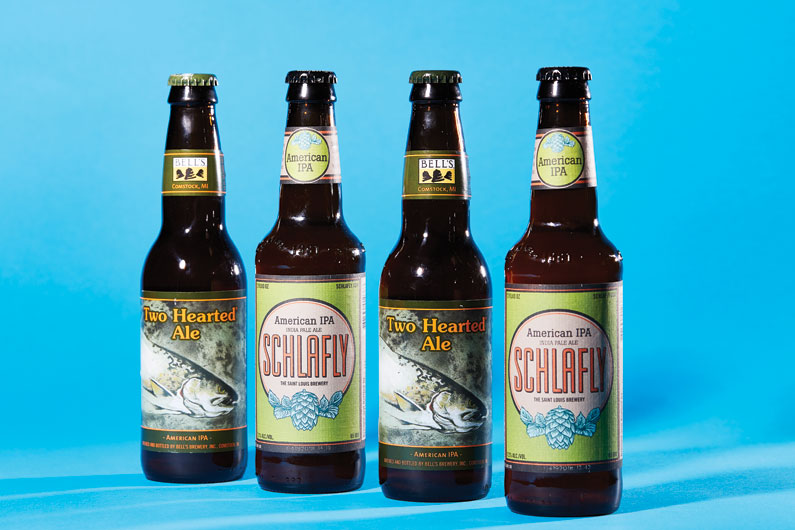Yes, you really do like IPAs – here's why
“I hate IPAs,” and “I don't like hops,” are two of the most common things beer-tenders hear behind the bar. The India pale ale – a hop-forward style originating in 19th-century England – is arguably the most divisive beer on the market. But some of the hop hatred is probably based on old information.
When the American craft movement was picking up, many brewers thought more was more when it came to hops, giving IPAs a reputation for palate-attacking bitterness. But today, the style is way more diverse.
IPAs have been at the helm of increased experimentation lately, allowing brewers to better understand the role hops play beyond the bittering agent used to balance a malt bill’s sweetness. Hops, especially when added after the boil (dry-hopping), can generate tons of aromas and flavor nuance.
Bitter isn’t for everyone, and that’s OK, but try a few of these increasingly popular variations before swearing off the style altogether.

THE OLD
The classic American IPA showcases a balanced hop and malt profile dominated by New World hop varietals and pale malts, is often dry-hopped and exudes a citrus, pine and resinous hop character.
Iconic // Anchor Brewing Liberty Ale
National Beauty // Bell’s Brewery Two Hearted Ale*
Local Perfection // Schlafly American IPA*
The West Coast IPA is an aggressively hopped American IPA intent on wreaking havoc on imbibers’ palates. Absurd amounts of hops go into the boil, creating excessive bitterness.
Iconic // Russian River Brewing Co. Pliny the Elder
National Beauty // Lagunitas Brewing Co. Lagunitas IPA*
Local Perfection // Urban Chestnut Brewing Co.Fantasyland*
THE NEW
The New England IPA is a fantastic introduction to what hops can do beyond bittering a beer. Hazy to opaque in color, these beers are juicy with abundant notes of tropical fruits and citrus, and they’re low in bitterness since most of the hops are used in dry-hopping.
Iconic // The Alchemist Heady Topper
National Beauty // Evil Twin Brewing Lost Souls*
Local Perfection // Any Narrow Gauge Brewing Co. NEIPA (sold exclusively at the Florissant brewery)
Milkshake or Smoothie IPAs one-up the New England IPA by incorporating loads of oats and lactose for a rich, shake-like quality. Cloudy as a rainy day and velvety in texture, these dessert beers push the limits with sweet adjuncts like vanilla, fruit, cereal or cookies.
Iconic // Omnipollo/Tired Hands Brewing Co. Milkshake Series
National Beauty // Odell Brewing Co. Cloud Catcher*
Local Perfection // 4 Hands Brewing Co.Smooth Operator*
*Available at Craft Beer Cellar

THE NEW-NEW
The Brut IPA was recently invented by Kim Sturdavant of San Francisco Social Kitchen and Brewery to counter the juice craze taking over the Eastern Seaboard. This exciting new genre is light-bodied, super crisp and bone dry. It’s the product of high-adjunct malt bills like flaked wheat and rice, post-boil hop additions and the complex sugar-eating enzyme amyloglucosidase, which helps produce zero grams of residual sugar in the final product.
Local hopoholic trendsetter 2nd Shift Brewing has already dabbled with a Brut IPA, knocking it out of the park with its Transient Artisan Alescollaboration and gearing up for a second limited release, available exclusively at the brewery this month.
Perennial Artisan Ales also has one landing this month called Ain’t It Strange, exclusively available at its tasting room. Expect low bitterness, a dry palate and a mildly dank, uber-tropical aroma from Galaxy hops.
The Sour IPA converges old school and new school potentially palate-wreaking styles. More and more dry-hopped sour beers are popping up, and with all the IPA experimentation, it makes total sense to add souring bacteria to an IPA for a unique yet complementary character.
Narrow Gauge recently collaborated with Central Standard Brewing out of Wichita, Kansas, for the Drop Ceiling, a New England-style IPA with souring bacteria aged in oak foedres on black currents.
Stay tuned, St. Louis. This is just the beginning.
Katie Herrera is a longtime contributor to Sauce Magazine, account manager at Craft Republic and director of beer at STL Barkeep.
Tags : Guide to Drinking, Beer






